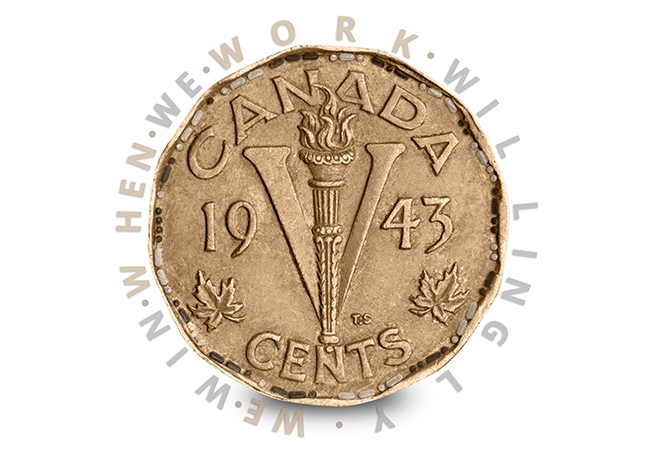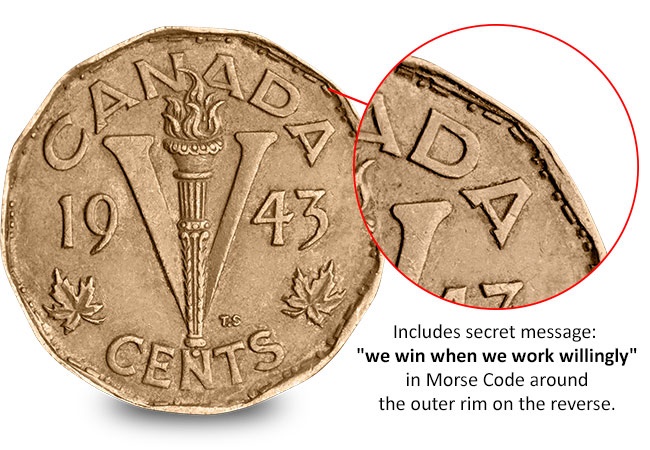Coin Info
The WWII Propaganda Coin
In 1943 the Second World War was far from won. It was a year to D-Day and two to VE Day.
Keen to encourage the war effort, the Canadian Government did something I have not seen anywhere else. They issued a coin as a piece of pure propaganda.

A Flaming Torch and “V” for Victory dominate the design, whilst the Morse code message on the coin’s rim read “We win when we work willingly”.
If you look closely, you will see the Morse code message just inside the bead of the coin on the reverse.

The ‘V’ represents the number five in Roman numerals for the coins face value, but also Winston Churchill’s famous V for Victory sign that had become synonymous with the hope of victory throughout the Allied nations.
Canadian officials felt it was important to have a patriotic symbol to support their war efforts. And as the coin was used by service men and women – as well as those at home – it did a great job at reminding people of the war effort.
This now legendary coin was minted right up until the end of the War in 1945.
The legendary coin with the hidden message
Click here to add an original Victory Nickel to your collection for just £10 >>
Revealed: The face of the new £20 banknote
Exciting news emerged over the weekend on who would replace economist Adam Smith on the £20 note.
Adam Smith’s image has featured on the £20 banknote since 2007, but early last year the Bank of England announced plans to replace him.
The bank of England asked the British public to nominate “people of historical significance” from the world of visual arts, from a list of 590 eligible candidates. Some of the nominations included Alfred Hitchcock, Isambard Kingdom Brunel, Richard Attenborough, Beatrix Potter and William Blake.
Of the 590 candidates, just 5 were shortlisted by a Bank committee and included – artist JMW Turner, designer Josiah Wedgwood, filmmaker Charlie Chaplin, sculptor Barbara Hepworth and painter William Hogarth.
The final decision was made by the Bank’s governor, Mark Carney and it has now been revealed that artist JMW Turner and his painting ‘The Fighting Temeraire’ will feature on the new £20 banknote.
Meet the new £20 note character: JMW Turner
Find out more: https://t.co/CsMLVfc9DJ#turner #jmwturner #20poundnote pic.twitter.com/5quxL5SnJz— Bank of England (@bankofengland) April 22, 2016
The design
The design features Turner’s self-portrait from 1788 along with one of his most famous paintings ‘The Fighting Temeraire’ which is a tribute to the ship HMS Temeraire which played an important role during the Battle of Trafalgar in 1805.
The quote ‘Light is therefore colour’ comes from a lecture by Turner at the Royal Academy in 1818 and his signature is taken from will when he donated all of his works to the nation.
Due to enter into circulation in 2020, the £20 note will be the third banknote made from Polymer, following on from the £5 note featuring Winston Churchill and the £10 note featuring Jane Austen. The £50 note will remain in circulation with the same design and there are currently no plans for them to be issued in polymer.
How rare is my £5 coin?
You may have noticed we’ve been talking about £5 coins a lot over the past few weeks and lots of collectors have been asking how rare their £5 coins are.
The £5 coin was first issued in 1990 as a replacement for the commemorative crown with a face value of 25p. They are usually reserved to commemorate significant British anniversaries and are a favourite among collectors as they are not intended for general circulation.
Using current Royal Mint figures we have put together three graphs where you can see just how rare your commemorative crown is, from the 1972 Silver Wedding Crown to the Brilliant Uncirculated Coronation £5 in 2013.
The differences in the mintage figures really are remarkable. Take a look below and see just how rare your £5 coin actually is.
The first crown ever to be issued was the 1972 Silver Wedding Coin and incidentally this is the rarest 25p UK coin from the Royal Mint with a mintage of 7,452,100. This 1972 crown was the first British coin to have a face value of 25 pence; previous crowns had been Five Shillings face value. Also, for the first time in modern times, the obverse did not incorporate a date, but merely bore the Queen’s name and titles surrounding her portrait.
The £5 coin with the lowest mintage in the history of UK £5 coins, is the circulated 2008 Prince Charles 60th Birthday £5 coin. Just 14,088 circulated quality coins were struck by the Royal Mint in 2008 to mark the 60th birthday of Prince Charles. The coins inscription ICH DIEN means ‘I serve’ and is taken from the Badge of the Prince of Wales.

* Individual Royal Mint BU Pack sales figures only

Out of the Brilliant Uncirculated £5 coins sold in individual The Royal Mint Packs, the 2014 Queen Anne £5 is the rarest. This coin has a mintage of just 12,181 and was struck to mark the 300th anniversary since the death of Queen Anne.The design bears an elegant portrait of Queen Anne, styled by Mark Richards FRBS as an eighteenth-century miniature.
How many of these £5 coins do you have in your collection? Do you own one of the rarest £5 coins? Let us know via Facebook, Twitter or leave a comment below!







